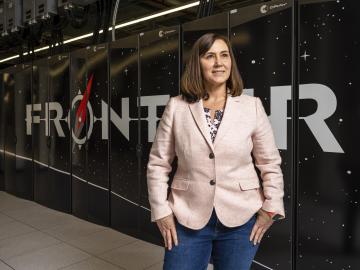
Filter News
Area of Research
News Topics
- (-) Big Data (21)
- (-) Cybersecurity (13)
- (-) Education (3)
- (-) Exascale Computing (18)
- (-) Fusion (23)
- (-) Isotopes (19)
- (-) Mercury (3)
- (-) Microscopy (15)
- (-) Security (6)
- 3-D Printing/Advanced Manufacturing (49)
- Advanced Reactors (17)
- Artificial Intelligence (34)
- Bioenergy (35)
- Biology (34)
- Biomedical (29)
- Biotechnology (8)
- Buildings (15)
- Chemical Sciences (29)
- Clean Water (7)
- Composites (7)
- Computer Science (62)
- Coronavirus (29)
- Critical Materials (9)
- Emergency (1)
- Energy Storage (42)
- Environment (72)
- Fossil Energy (2)
- Frontier (20)
- Grid (23)
- High-Performance Computing (36)
- Hydropower (3)
- Irradiation (2)
- Machine Learning (23)
- Materials (61)
- Materials Science (55)
- Mathematics (4)
- Microelectronics (2)
- Molten Salt (3)
- Nanotechnology (24)
- National Security (23)
- Neutron Science (67)
- Nuclear Energy (55)
- Partnerships (24)
- Physics (27)
- Polymers (11)
- Quantum Computing (12)
- Quantum Science (23)
- Simulation (29)
- Software (1)
- Space Exploration (8)
- Summit (26)
- Transportation (33)
Media Contacts

With the world’s first exascale supercomputer now fully open for scientific business, researchers can thank the early users who helped get the machine up to speed.

Tristen Mullins enjoys the hidden side of computers. As a signals processing engineer for ORNL, she tries to uncover information hidden in components used on the nation’s power grid — information that may be susceptible to cyberattacks.

Creating energy the way the sun and stars do — through nuclear fusion — is one of the grand challenges facing science and technology. What’s easy for the sun and its billions of relatives turns out to be particularly difficult on Earth.

Scientist-inventors from ORNL will present seven new technologies during the Technology Innovation Showcase on Friday, July 14, from 8 a.m.–4 p.m. at the Joint Institute for Computational Sciences on ORNL’s campus.

To support the development of a revolutionary new open fan engine architecture for the future of flight, GE Aerospace has run simulations using the world’s fastest supercomputer capable of crunching data in excess of exascale speed, or more than a quintillion calculations per second.

ORNL will team up with six of eight companies that are advancing designs and research and development for fusion power plants with the mission to achieve a pilot-scale demonstration of fusion within a decade.

Lawrence Livermore National Laboratory’s Lori Diachin will take over as director of the Department of Energy’s Exascale Computing Project on June 1, guiding the successful, multi-institutional high-performance computing effort through its final stages.

When reading the novel Jurassic Park as a teenager, Jerry Parks found the passages about gene sequencing and supercomputers fascinating, but never imagined he might someday pursue such futuristic-sounding science.

At the National Center for Computational Sciences, Ashley Barker enjoys one of the least complicated–sounding job titles at ORNL: section head of operations. But within that seemingly ordinary designation lurks a multitude of demanding roles as she oversees the complete user experience for NCCS computer systems.

Nature-based solutions are an effective tool to combat climate change triggered by rising carbon emissions, whether it’s by clearing the skies with bio-based aviation fuels or boosting natural carbon sinks.


